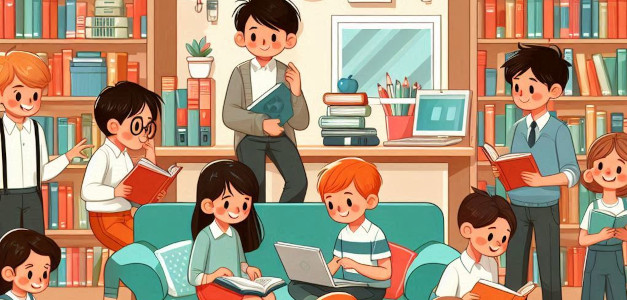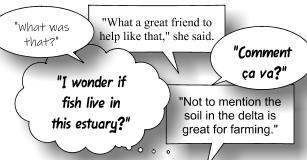The 21st Century Author Study
Technology transforms the process from teacher- to student-centered

21st technology has certainly transformed how our students read and write, yet author study remains a fixture of the curriculum. As a second-generation teacher, I find author study a great way to engage students in reading and the reading process. New technologies and techniques have helped me redefine this powerful teaching tool to pique the interest of 21st-century learners.
Technology makes it easier to find, use, reuse, and share author study materials.
In a project-based approach to teaching and learning, students work to apply what they know to solve a real-world problem. Students explore the curriculum in depth as they apply knowledge to resolve questions, determine connections, and assess relationships. During the project-based learning process, students also engage and hone thinking, communication, leadership, collaboration, and other essential 21st century skills.
My mother, a 20th-century ELA teacher, had to comb actual library shelves and bookstores to find author biographies, magazine articles, and images of authors; I can simply go online (even from my phone!) to perform a simple search that returns a slew of sources. While my mother would carefully clip out author pictures or relevant images and then work or hours to mount them for reuse, I simply print my results or add them to digital presentations I share with my students.
My mother could never part with her precious author materials to share with a distant colleague, but I can easily collect my curated resources into a digital folder and share them with colleagues in Pennsylvania, Florida, or even London. Had one of her prized collections been lost or damaged, what would she have done? The digital nature of my files means that even if a page gets ripped or goes missing, I can simply print another to replace it.
Technology makes it easier to involve students in the process, not just the result.
Information and presentation technologies also allow me to involve my students in all aspects of the author study process, including the process of locating materials. While my mother had to independently collect, borrow, and assemble author study resources, I can task my students with researching an author and compiling resources. Even if they find information online that doesn’t hold up to the facts or come across a story on a questionably reliable site about an author’s indelicate reaction to how their novel was transformed into a movie, I consider these opportunities I can use to help my students evaluate online information.
I introduce my students to the author study research process by modeling how easy it is to find information on authors from website, blogs, YouTube, Twitter and other online resources. The students in my mother’s classroom never needed to assess and curate the author-related content she assembled. My students must learn how to be effective consumers, evaluators, and producers of a torrent of social network data.
My students learn to differentiate between factual information and popular (but not necessarily factual) stories about an author, skills they can also apply as they read their teen fan magazines. For example, when students find rumors that 89-year old Harper Lee did not approve the release of the original draft of Go Set a Watchman or that her real name was Jean Louise, they recognize the need to perform supplementary research to verify the accuracy and truth of online resources.
In addition to locating author information and resources, students also comment on the videos and photos they find, presenting their research as part of a narrated presentation using tools like Power Point, or Wixie. When they go on to another teacher, their contributions toward (and credit for) our collaborative author studies remain, serving to both educate and inspire subsequent learners.
Student excitement about the resources and information they find and curate is sometimes so great that they are compelled to develop their own fan web sites or blog entries about a specific author. They often link to established author fan sites or authors' Facebook pages, becoming part of the social network of readers, bloggers, Tweeters, and Instagram commentators.
Technology makes it easier to actually connect with authors.
My mother was frequently able arrange visits by well-known authors to her classes, but she wasn't able to do this year after year. Her students would often send letters and fan questions to an author’s publisher, and if they did receive a reply, it was usually a publicity photo or a pre-printed thank you that answered none of the students’ questions.
In contrast, when I have my students develop a set of questions for an author, I challenge them to answer as many questions as possible from the author's site. Students find that many of their questions are already answered. I encourage them to submit their remaining questions to the author’s email address, guestbook, or blog.
Students can also post to an author's Facebook fan page or to an author's social media account. While this does not guarantee a response from the author, my students enjoy a greater likelihood of receiving a response to their questions than the students in my mother's 1980’s classes. My students were blown away when they received digital responses from authors R.L. Stine, Sharon Draper, Jacqueline Woodson, Veronica Chambers, E. Lockhardt, Ralph Fletcher, Trudy Ludwig, and Adam Gidwitz!
Authors are often willing to arrange, for a small fee, a Skype chat with students, allowing them to ask questions face-to-face and to hear and see the author respond. Some publishers, like Scholastic, often host free web chats with authors, allowing students to experience the author’s speaking style, voice, and appearance. Some students prepare posters and other materials to greet authors at the beginning of a session. While an online chat isn't quite the same as having Judy Blume or Kwame Alexander sitting in your classroom, this technology provides authors the ability to visit with more students and to interact with learners in distant locations.
Some authors have a large social media presence.
Some authors, like Judy Blume, have an extensive online and social media presence. Students can create a set of questions, visit Judy Blume's official web site, and explore her Q & A and “For Kids” pages to get answers. They can read her blog, write in her guest book, explore her online journal and diary of activities, and, if they read far enough back, learn how she dealt with cancer.
Although it is unlikely my students will have the benefit of Ms. Blume personally visiting our class, they can learn about her by watching her You Tube videos. They can verify whether Wikipedia’s facts about Judy are correct by comparing its article with the biographical data on her personal site. Students can Judy on Facebook, read the current messages on her official fan page, and even subscribe to her Twitter feed to learn about her interests and passions.
So what do they do with all of this information? They can create their own repository of facts and information to share with other kids. They can prepare lessons for younger peers to explore a particular Judy book or hold a book club luncheon with a trivia contest about her books.
I can gauge their ability to read and research relevant data from a range of digital resources and create my own version of a data scavenger hunt. Where was Judy born, and why is that important for readers of her latest book? What color is her hair? How does a dentist fit in her life and figure in her latest book? What American history events do you need to learn about in order to fully understand her latest book?
In the summer of 2015, I sat down at my laptop and found a site that contained a note from a distraught new husband in Greenpoint, Brooklyn who has lost his wife’s autographed copy of Are You There, God, It’s Me, Margaret. I learned that Judy Blume offered him a new signed copy to redeem himself in the eyes of his wife! How do I know? Time Magazine, CBS News, and Entertainment Weekly (non-traditional author study sources) covered the story. I then asked my students to compare all three versions of the same story and separate fact from fiction.
Reclusive - and even dead - authors are alive and well online!
Harper Lee, age 89, is currently confined to an assisted living facility and may be too infirm to give interviews. Even in the heyday of her To Kill a Mockingbird celebrity, she seemingly dodged the media and avoided the spotlight. Or did she? Challenge students to use the Web to identify archival video of public appearances, key speeches for social causes, and the television and award appearances for which Harper emerged. You, and your students, may be surprised at the multiple instances of Harper using media for a deliberate purpose!
Harper Lee offers numerous other opportunities for compelling online author investigations. For example:
- What articles and commentary have fueled the current controversy about her draft of Go Set a Watchman, which emerged in 2015 as her second published book?
- What did Harper Lee say when she received her Pulitzer Prize?
- In what ways was the character of Atticus modeled on her father?
- Did Harper Lee like Gregory Peck's portrayal as Scout's father?
- What childhood pal turned out to be a writer who loved the media spotlight?
Judy Blume, in all her engaging personal vigor, is willing to be studied. You can follow her on Twitter and maybe even arrange an on-site visit, making her a great author to study. But Harper Lee is also a fun and powerful choice; even a private, media-shy author provided a wealth of digital data and resources which can be investigated as part of 21st century author study.
Once you choose an author to explore, suggest (after appropriate review) some online resources and pose a few questions to get your students started. Remind students that you don't merely want a simple review of sites and a list of data about the author. The best author studies are ones where your students, with your help and encouragement, discover how to be powerful online researchers and become part of an online community of passionate readers and writers.











